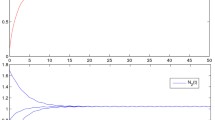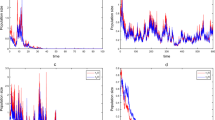Abstract
An increased number of economical birds is one of the major threats affecting migratory birds population. In this paper, we consider two competing species: rare migratory bird and economical bird, and investigate a nonautonomous two species competitive model with a Holling-type II functional response, which the pulse culling is incorporated. By utilizing an analyzing method, sufficient and realistic conditions on permanence, extinction of the two species, existence of positive periodic solution, and the global attractivity of semitrivial periodic solution are established. The theoretical results are confirmed by numerical simulations.
Similar content being viewed by others

References
Dong, L., Liao, J.: Neural network-based biomass estimation in the Poyang lake wetland using Envisat ASAR data. Remote Sens. Technol. Appl. 24, 325–330 (2009)
Zhang, F., Gao, S.: On the migratory birds population model with pulse diffusion. In: Proceedings of the 7th Conference on Biological Dynamic System and Stability of Differential Equation, vol. 1, pp. 417–421. World Academic Press, Liverpool (2010)
Chatterjee, S.: Role of migratory birds under environmental fluctuation—a mathematical study. J. Biol. Syst. 16, 81–106 (2008)
Wang, W., Shen, J.: Partial survival and extinction in two competing species with impulses. Nonlinear Anal., Real World Appl. 10, 1243–1254 (2009)
Hou, J., Teng, Z.: Permanence and global stability for nonautonomous N-species Lotka–Volterra competition system with impulses. Nonlinear Anal., Real World Appl. 11, 1882–1896 (2010)
Ahmad, S., Stamova, I.M.: Asymptotic stability of competitive systems with delays and impulsive perturbations. J. Math. Anal. Appl. 334, 686–700 (2007)
Teng, Z., Chen, L.: The positive periodic solutions in periodic Kolmogorov type systems with delays. Acta Math. Appl. Sin. 22, 446–456 (1999) (in Chinese)
Li, J., Yan, J.: Persistence for Lotka–Volterra patch-system with time delay. Nonlinear Anal., Real World Appl. 9, 490–499 (2008)
Nie, L., Teng, Z.: Qualitative analysis of a modified Leslie–Gower and Holling-type II predator-prey model with state dependent impulsive effects. Nonlinear Anal., Real World Appl. 11, 1364–1373 (2010)
Cui, J.: The effect of dispersal on permanence in a predator-prey population growth model. Comput. Math. Appl. 44, 1085–1097 (2002)
Liu, Z., Teng, Z.: Two patches impulsive diffusion periodic single-species logistic model. J. Biomath. 3, 127–141 (2010)
Teng, Z.: Uniform persistence of the periodic predator-prey Lotka–Volterra systems. Appl. Anal. 72, 339–352 (1998)
Cui, J.: Permanence of predator-prey system with periodic coefficients. Math. Comput. Model. 42, 87–98 (2005)
Tineo, A.: An iterative scheme for the N-competing species problem. J. Differ. Equ. 116, 1–15 (1995)
Ahmad, S., Montesde Oca, F.: Extinction in nonautonomous T-periodic competitive Lotka–Volterra system. Appl. Math. Comput. 90, 155–166 (1998)
Ahmad, S., Montesde Oca, F.: Average growth and extinction in a two dimensional Lotka–Volterra system. Dyn. Contin. Discrete Impuls. Syst. 9, 177–186 (2002)
Montesde Oca, F., Zeeman, M.L.: Extinction in nonautonomous competitive Lotka–Volterra systems. Proc. Am. Math. Soc. 124, 3677–3687 (1996)
Teng, Z., Li, Z.: Permanence and asymptotic behavior of the N-species nonautonomous Lotka–Volterra competitive systems. Comput. Math. Appl. 39, 107–116 (2000)
Cui, J., Chen, L.: The effect of dispersal on population growth with stage-structure. Comput. Math. Appl. 39, 91–102 (2000)
Cui, J., Chen, L.: The effect of habitat fragmentation and ecological invasion on population sizes. Comput. Math. Appl. 38, 1–11 (1999)
Bainov, D.D., Simeonov, P.S.: Impulsive Differential Equations: Periodic Solutions and Applications. Longman, London (1993)
Author information
Authors and Affiliations
Corresponding author
Rights and permissions
About this article
Cite this article
Zhang, F., Gao, S. & Zhang, Y. Effects of pulse culling on population growth of migratory birds and economical birds. Nonlinear Dyn 67, 767–779 (2012). https://doi.org/10.1007/s11071-011-0025-3
Received:
Accepted:
Published:
Issue Date:
DOI: https://doi.org/10.1007/s11071-011-0025-3



